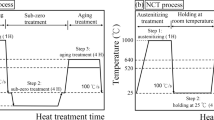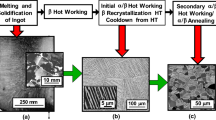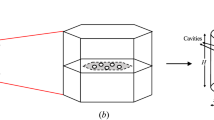Abstract
Fatigue damage gets accentuated by localized stresses and strains contributing to crack initiation and growth, resulting in component failures. Cracks being high-energy defects require in situ or preexisting stress concentrations for their initiation and growth. Generally, large grains close to the surface deform more readily, resulting in localized slip bands, intrusions, protrusions, and, thus, deformation-induced stress concentrations, which can initiate cracks. In some cases, localized stresses and strains can cause plasticity-induced phase transformations that can reduce these stresses. If this happens near the crack tip, the reduced crack tip stresses contribute to crack tip toughening, thereby increasing resistance to subsequent crack growth. We have well established in the past that fatigue damage is characterized by two load parameters, maximum stress and stress amplitude. It is the applied maximum stress that causes the local plasticity-induced transformations. Hence, the transformation-induced toughening process at the crack tip must be correctly analyzed considering maximum stress intensity factor, Kmax contributing to stress or strain-induced transformation ahead of the crack tip. This paper reanalyzes the available fatigue data of some austenitic stainless steels that undergo localized plasticity-induced transformations, considering the two load-parametric nature of fatigue damage.















Similar content being viewed by others
References
Basu K, Das M, Bhattacharjee D, Chakraborti PC (2007) Effect of grain size on austenite stability and room temperature low cycle fatigue behaviour of solution annealed AISI 316LN austenitic stainless steel. Mater Sci Technol 23:1278–1284
Bogers AJ, Burgers WG (1964) Partial dislocations on the 110 planes in the bcc lattice and the transition of the fcc into the bcc lattice. Acta Metall 12:255–261
Chatterjee S, Badeshia HKDH (2007) Transformation induced plasticity assisted steels: stress or strain affected martensitic transformation? Mater Sci Technol 23:1101–1104
Chatterjee S, Wang HS, Yang JR, Bhadeshia HKDH (2006) Mechanical stabilisation of austenite. Mater Sci Technol 22:641–644
Das A, Chakraborti PC, Tarafder S, Bhadeshia HKDH (2011) Analysis of deformation induced martensitic transformation in stainless steels. Mater Sci Technol 27:366–370
Donald J (1988) A procedure for standardizing crack closure levels. In: Newman J, W (eds) Mechanics of fatigue crack closure. ASTM International, West Conshohocken, pp 222–229. https://doi.org/10.1520/STP27211S
Eichelman GH, Hull FC (1953) The effect of composition on the temperature of spontaneous transformation of austenite to martensite in 18–8 stainless steel. Trans ASM 45:77–104
Elber W (1971) The significance of fatigue crack closure. In: Damage tolerence in aircraft structures. ASTM STP 486. ASTM Philadelphia, pp 230–242
Goodman J (1899) Mechanics applied to engineering. Longmans, London
Kitagawa H, Takahashi S (1976) Applicability of fracture mechanics to very small cracks or the cracks in the early stages. In: Proceedings of the second international conference on mechanical behavior of materials. American Society for Metals, Metals Park, pp 627–631
Kujawski D (2001) A new (DK, Kmax) driving force parameter for crack growth in aluminum alloys. Int J Fatigue 23(8):733–740. https://doi.org/10.1016/S0142-112301)00023-8
Louat N, Sadananda K, Duesbery M, Vasudevan AK (1993) A theoretical evaluation of crack closure. Metall Trans A 24:2225–2232
Martelo DF, Chapetti MD (2013) Fatigue crack growth in a metastable austenitic stainless steel, presented at the 13th international conference on fracture, June 16–21, Beijing, China. https://core.ac.uk/download/pdf/208669043.pdf
Martelo DF, Mateo A, Chapetti MD (2015) Crack closure and fatigue crack growth near threshold of a metastable austenitic stainless steel. Int J Fatigue 77:64–77
Mei Z, Morris JW Jr (1990) Influence of deformation-induced martensite on fatigue crack propagation in 304-type steels. Met Trans 21A:3137–3152
Mei Z, Change G, Morris Jr JW (1988) Fatigue crack growth in metastable austenitic stainless steels, invited talk presented at the international conference on cryogenic materials, applications and properties, Shenyang, China, report LBL-24949. Lawrence Berkeley Laboratory, University of California
Nani Babu M, Sasikala G, Sadananda K (2019) Effect of nitrogen on the fatigue crack growth behavior of 316L austenitic stainless steels. Metall Mater Trans A 50:3091–3105. https://doi.org/10.1007/s11661-019-05225-w
Newman JC Jr. (1974) Finite-element analysis of fatigue crack propagation—including the effects of crack closure, Ph. D. Thesis, Virginia Polytechnic Institute and State University, Blacksburg, VA
Olson GB (1996) Transformation plasticity and toughening. J Phys IV Proc EDP Sci 6(C1):407–418
Olson GB, Cohen M (1972) A Mechanism for the strain-induced nucleation of martensitic transformation. J Less Common Met. 28:107–118
Sadananda K, Vasudevan AK (2003) Multiple mechanisms controlling fatigue crack growth. Fatigue Fract Eng Mater Struct 26(9):835–845. https://doi.org/10.1046/j.1460-2695.2003.00684.x
Sadananda K, Vasudevan AK (2005) Fatigue crack growth behavior of titanium alloys. Int J Fatigue 27:1255–1266
Sadananda K, Sarkar S, Kujawski D, Vasudevan AK (2009) A two-parameter analysis of S-N fatigue life using Δσ and σmax. Int J Fatigue 31:1648–1659
Sadananda K, Nani Babu M, Vasudevan AK (2019) A review of fatigue crack growth resistance in the short crack growth regime. Mater Sci Eng A 754:674–701
Suresh S (1991) Fatigue of metals. University Press, Cambridge
Tao K (2006) Effects of temperature and grain size on the transformation and the deformation behaviors of the TRIP (transformation induced plasticity) steels, Ph.D. Thesis. The University of Tennessee, Knoxville
Vasudevan AK, Sadananda K, Louat N (1994) A review of crack closure, fatigue crack threshold and related phenomena. Mater Sci Eng A 188:1–22
Xie L, Wang C, Wang Y, Wu G, Huang X (2019) Grain size effect on the mechanical behavior of metastable Fe-23Cr-8.5Ni Alloy. Metals 9:734. https://doi.org/10.3390/met9070734
Acknowledgements
KS and NI acknowledge the support from the Navy Contract# N68335-16-C-0135 with Dr. Anisur Rahman as the program officer.
Author information
Authors and Affiliations
Corresponding author
Additional information
Publisher's Note
Springer Nature remains neutral with regard to jurisdictional claims in published maps and institutional affiliations.
Rights and permissions
About this article
Cite this article
Sadananda, K., Iyyer, N. & Babu, M.N. Effects of Localized Plasticity-Induced Transformation on Fatigue Crack Growth. Trans Indian Natl. Acad. Eng. 7, 385–395 (2022). https://doi.org/10.1007/s41403-021-00255-6
Received:
Accepted:
Published:
Issue Date:
DOI: https://doi.org/10.1007/s41403-021-00255-6




